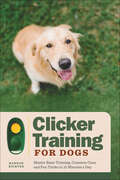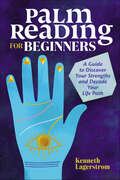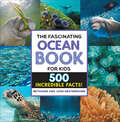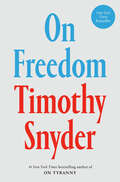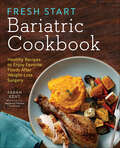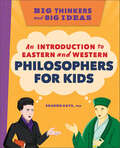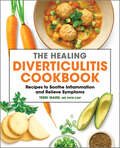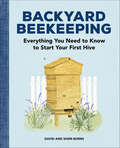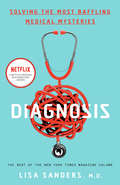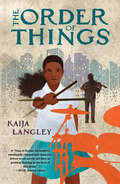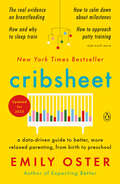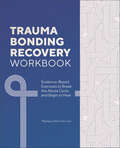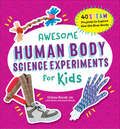- Table View
- List View
Clicker Training for Dogs: Master Basic Training, Common Cues, and Fun Tricks in 15 Minutes a Day
by Hannah RichterClicker train your dog in just 15 minutes a day with this easy-to-use guideClicker training uses positive reinforcement to teach your dog new skills and behaviors—just command, click, reward, and repeat! Clicker Training for Dogs makes training easy for both you and your canine friend, with short, targeted lessons that teach everything from basic cues to fun tricks. You'll also learn how to use clicker training for dogs to solve common behavioral problems, including barking for attention and pulling on the leash.Clicker Training for Dogs includes:Brief bursts of training—Short sessions—just 15 minutes a day—make it easy to find time for consistent dog training while being brief enough to keep your pup engaged.Step-by-step instructions—Find clear directions that break down each training lesson into small steps so you can feel confident that you're teaching each concept correctly.Pro tips—Get pointers that help you make the most out of each training session and troubleshoot potential setbacks, such as your dog getting confused.Improve your pup's behavior and build a stronger bond with Clicker Training for Dogs.
Palm Reading for Beginners: A Guide to Discovering Your Strengths and Decoding Your Life Path
by Kenneth LagerstromYour spiritual journey is in your hands—the essential guide to palm readingWhat if the answers you've been looking for are right there, in the palm of your hand? If you're a novice to the practice of palmistry and want to dive deep into this alluring subject, Palm Reading for Beginners will show you how to look through a window into your past, present, and future presented in one single, universal language—our hands.From improving mental clarity to understanding your own potential, this book combines all the core principles of this ancient art. Learn to analyze the lines and mounts of the palm, hand movements and shapes, and patterns of fingerprints to put them together and apply meaning to everyday life.Palm Reading for Beginners interesting tidbits include:Profound and relatable—The how-to information is in-depth, thorough, and easy-to-understand making your palm reading journey easy.Invaluable insight—Use these essential palm reading methods to not only examine a hand but interpret what you see.Illuminating illustrations—The clear and concise drawings make it that much easier for you to perfect the practice.With Palm Reading for Beginners, you'll see your life in ways you never thought possible.
Kitchen Witchcraft for Beginners: Spells, Recipes, and Rituals to Bring Your Practice Into the Kitchen
by Dawn Aurora HuntTransform your kitchen into a transcendent space The kitchen can be a very powerful place—and that's precisely what makes it ideal for practicing witchcraft. This beginner's guide shows you how to channel your intention and energy into delicious dishes and effective elixirs that can conjure love, health, and so much more.Uncover your inner witch—Learn what it means to be a witch, practice the craft, and unearth the sacred in the everyday.Prep your kitchen—Get ready to become a kitchen witch as you learn how to prepare the space for spellwork and explore the supplies you'll want to have on hand for magical success.Magical dishes—Dive into a range of delectable recipes and potent rituals all designed to nurture relationships, build community, and feed the soul.Nourish your spirit as you learn to whip up some kitchen magic with this leading witch cookbook.
The Fascinating Ocean Book for Kids: 500 Incredible Facts! (Fascinating Facts)
by Bethanie Hestermann Josh HestermannFrom anemones to zooplankton—500 awesome ocean facts for kids ages 8 to 12Do you know a kid who's captivated by what goes on beneath the ocean's surface? This sea animal book for kids is packed with hundreds of incredible facts for hours of underwater exploration. Pages of full-color pictures feature life in and around the sea including fish, dolphins, and shipwrecks!Dive deeper than other ocean books for kids with ocean trivia such as: Sea cucumbers can eject some of their organs to defend themselves and then regrow them within a few weeks.The Challenger Deep is the deepest place on Earth, almost 7 miles below the surface of the Pacific Ocean.Blue whales are the largest animals that have ever lived—their tongue weighs as much as an entire elephant!Kids will light up as they discover fascinating fishes and deep-sea giants with the best in ocean books for kids. It's also an ideal choice for Christmas gifts or kids' stocking stuffers, sparking curiosity and wonder during the holiday season.
On Freedom
by Timothy SnyderNEW YORK TIMES BESTSELLER • A brilliant exploration of freedom—what it is, how it&’s been misunderstood, and why it&’s our only chance for survival—by the acclaimed Yale historian and author of the #1 New York Times bestseller On Tyranny&“A rigorous and visionary argument . . . Buy or borrow this book, read it, take it to heart.&”—The GuardianTimothy Snyder has been called &“the leading interpreter of our dark times.&” As a historian, he has given us startling reinterpretations of political collapse and mass killing. As a public intellectual, he has turned that knowledge toward counsel and prediction, working against authoritarianism here and abroad. His book On Tyranny has inspired millions around the world to fight for freedom. Now, in this tour de force of political philosophy, he helps us see exactly what we&’re fighting for.Freedom is the great American commitment, but as Snyder argues, we have lost sight of what it means—and this is leading us into crisis. Too many of us look at freedom as the absence of state power: We think we're free if we can do and say as we please, and protect ourselves from government overreach. But true freedom isn&’t so much freedom from as freedom to—the freedom to thrive, to take risks for futures we choose by working together. Freedom is the value that makes all other values possible.On Freedom takes us on a thrilling intellectual journey. Drawing on the work of philosophers and political dissidents, conversations with contemporary thinkers, and his own experiences coming of age in a time of American exceptionalism, Snyder identifies the practices and attitudes—the habits of mind—that will allow us to design a government in which we and future generations can flourish. We come to appreciate the importance of traditions (championed by the right) but also the role of institutions (the purview of the left). Intimate yet ambitious, this book helps forge a new consensus rooted in a politics of abundance, generosity, and grace.
Island Witch
by Amanda Jayatissa"Every once in a while, a book comes along that drops you into another world and takes you places you never could imagine. This is that book. An astounding accomplishment!" —R. L. Stine, author of GoosebumpsSet in nineteenth-century Sri Lanka and inspired by local folklore, Island Witch follows the daughter of a traditional demon-priest—relentlessly bullied by peers and accused of witchcraft herself—tries to solve the mysterious attacks that have been terrorizing her coastal village.Being the daughter of the village Capuwa, or demon-priest, Amara is used to keeping mostly to herself. Influenced by the new religious practices brought in by the British Colonizers, the villagers who once respected her father&’s craft have turned on the family. Yet, they all still seem to call on him whenever supernatural disturbances arise.Now someone—or something—is viciously seizing upon men in the jungle. But instead of enlisting Amara&’s father&’s help, the villages have accused him of carrying out the attacks himself.As she tries to clear her father&’s name, Amara finds herself haunted by dreams that eerily predict the dark forces on her island. And she can&’t shake the feeling that it&’s all connected to the night she was recovering from a strange illness, and woke up, scared and confused, to hear her mother&’s frantic cries: No one can find out what happened.
30-Minute Watercolor Painting for Beginners: Easy Step-by-Step Lessons and Techniques
by Rockridge PressLearn to create your own gorgeous watercolor artwork—in just 30 minutes at a time!Master watercolor basics while creating your own frame-worthy art following the fun and simple lessons in this watercolor book for adults. Beautifully presented instructions and illustrations show you the fundamentals of watercolor for beginners, so you can develop your skills in a series of projects, from a dramatic landscape to an abstract art piece. Best of all, each lesson is designed to take 30 minutes or less, so it's easy to make time for art and learning a new skill!No experience required—Learn how to choose and assemble your supplies, and how to paint using color theory and composition techniques.Practice watercolor techniques—Mix colors and try various brushstrokes and washes over the course of 5 different lessons.Paint! —Produce your own artwork with 15 painting projects with step-by-step instructions on how to watercolor flowers, animals, and more.Start painting today with 30-Minute Watercolor Painting for Beginners!
Zen Meditation for Beginners: A Practical Guide to Inner Calm
by Bonnie Myotai TreaceCenter yourself and find calm—simple Zen meditation for beginnersBeginning Zen meditation is a step into the unknown—let Zen Meditation for Beginners be your guide. This simple, straightforward handbook shows you how to embrace the beauty and clarity of the present moment—helping you destress and find balance at home, at work, or wherever you are.Discover 10 different Zen principles, and find out how to apply their wisdom in your everyday life. This book of meditation for beginners shows you how to bring important principles of Zen to life in your own meditation. When you leave your seated practice, post-meditation exercises help you take that peace with you on your journey.Zen Meditation for Beginners includes:A few minutes of peace—Take a break with these short practices—most take five or 10 minutes, and some can be done while you go about your day.Find what you need—Meditate on themes for the modern day, like Embodying Kindness, Noticing Negative Self-Speak, No Big Deal, and more.Clear and simple—No previous Zen experience necessary—this book on meditation for beginners walks you through the basics, so you can relax and move forward confidently.Invite a few moments of calm into your busy day with Zen Meditation for Beginners.
Back Pain Relief Plan: A 20-Minute Exercise-Based Program to Prevent, Manage, and Ease Pain
by Ricky FishmanEase and prevent back pain with low-impact workouts that strengthen and healDiscover how you can use exercise to more effectively manage your back pain. This comprehensive guide provides critical information about back pain causes and treatments as well as several holistic workout programs designed to accommodate a variety of unique needs. You only need about 20 minutes a day to start helping your back, and this plan will show you the way.The Back Relief Plan features:Back pain facts—Learn about the causes of back pain, the various medical interventions available to you, and lifestyle changes that can help you take care of your back and avoid worsening pain.Exercise plans—Discover a range of simple workout routines, from gentle to advanced, that combine stretching, cardio, and core strengthening.Workout guides—Keep your workout safe and effective with illustrated, step-by-step instructions, as well as handy tips for properly performing each exercise.Get the practical pain solutions you need from the Back Relief Plan.
Awesome Architecture Activities for Kids: 25 Exciting STEAM Projects to Design and Build (Awesome STEAM Activities for Kids)
by Andrea Mulder-Slater Jantje Blokhuis-Mulder Geoff SlaterGet kids excited about architecture with hands-on activities for ages 5 to 10Architects create the spaces we use every day—but how do they know what a building should look like? Kids will uncover the answer with this book of 25 at-home architecture activities! Inside, they'll explore the key principles of building and design through creative projects like constructing a bridge, designing a garden, and planning a shopping center.Architecture and engineering books for kids like this one can help kids develop their problem-solving skills as they answer questions about each activity and take notes on what they learn. Best of all, the projects get more challenging as the book progresses, encouraging kids to apply their new knowledge to the next activities. Kid-friendly instructions—Step-by-step guidance and illustrations make these projects easy for kids to do with minimal supervision.No special equipment required—These projects use inexpensive everyday items like blankets, popsicle sticks, and tin cans, so kids can get started right away.See the STEAM connection—Discover how each architecture activity fits into the world of science, technology, engineering, art, and math.Encourage kids to see the world around them in a new way with this book of architecture for kids!
The Easy Arthritis Diet Cookbook: 75 Anti-Inflammatory Recipes to Manage Symptoms
by Ruth FrechmanFind relief from arthritis with simple, soothing recipes A healthy, anti-inflammatory diet can help reduce your joint pain and improve your overall health. This cookbook simplifies an arthritis-friendly diet, with truly easy recipes that require minimal prep and a limited number of basic ingredients.What sets The Easy Arthritis Diet Cookbook apart from other arthritis books:The arthritis-diet connection—Learn how dietary changes can ease common arthritis symptoms; tips for sticking to a healthy diet; and which foods to enjoy, moderate, and avoid.A focus on ease and convenience—Explore flavorful recipes designed to minimize time and effort, with handy labels for dishes made from 5 or fewer ingredients, one-pot meals, or recipes that take 30 minutes or less to prep.A variety of delicious dishes—Enjoy tasty anti-inflammatory dishes for every meal, from a Spicy Peach Ginger Smoothie for breakfast to Lemony Roasted Chicken and Root Vegetables for dinner.Prepare effortless meals that help relieve your arthritis symptoms with this hassle-free anti-inflammatory cookbook.
Fresh Start Bariatric Cookbook: Healthy Recipes to Enjoy Favorite Foods After Weight-Loss Surgery
by Sarah KentRediscover the pleasure of food after weight-loss surgeryWeight loss surgery doesn't have to mean giving up your favorite recipes for good. This up-to-date bariatric cookbook puts a surgery-safe twist on foods with 100+ healthy, comforting recipes that are simple enough to make every day, so you can sustain your long-term weight-loss and health goals.Learn how to implement the right portions, increase protein in your meals, and use the most nutritious ingredients, so your food is as good for you as it is delicious. With nutritional information for every recipe, keeping track of your fluid and calorie intake is easy.The Fresh Start Bariatric Cookbook is a new nutrition plan for your new body, featuring:Options for every stage—Each recipe is marked with an icon that tells you which stage of post-operation it's appropriate for: full liquid, puree, soft foods, or general diet.Flavorful recipes—Enjoy comfort foods like Chocolate-Peanut Butter Smoothies, Turkey Breakfast Burritos, Baked Salmon with Barbecue Seasoning, Low-Carb Cheeseburger Casserole, and much more.Foods for every body—These dishes are crafted to meet your needs after gastric sleeve surgery (or vertical sleeve gastrectomy), laparoscopic adjustable gastric band placement, and more.Enjoy some of your favorite foods while staying on the path to better health and weight loss with this bariatric cookbook.
Big Thinkers and Big Ideas: An Introduction to Eastern and Western Philosophers for Kids
by Sharon KayeAn introduction to 25 major philosophers for kids ages 8 to 12 Learning about philosophy encourages kids to ponder big ideas and ask deep questions about the world around them. This book introduces kids to 25 major Eastern and Western philosophers with easy-to-understand explanations of their most well-known ideas.What sets this book about philosophy for kids apart:An introduction to philosophy—Kids will learn more about what a philosopher is, what kind of questions they ask, and the history of Eastern and Western philosophy.Thinkers throughout time—This book covers ancient philosophers like Socrates and Confucius, medieval philosophers like Averroes and Hildegard of Bingen, and modern philosophers like Simone de Beauvoir and Mohandas Gandhi.Thought-provoking questions—Get kids thinking with philosophical questions that help them consider opposing ideas, develop strong arguments, and strengthen their communication skills.Pick up this kid-friendly choice in philosophy books and inspire the budding philosopher in your life.
The Healing Diverticulitis Cookbook: Recipes to Soothe Inflammation and Relieve Symptoms
by Terri WardSoothe your diverticulitis discomfort with easy, healthy recipes Living with a painful gastrointestinal disease like diverticulitis can make eating a challenge—but it doesn't have to be that way. This cookbook has expert nutritional guidance and diverticulitis-safe recipes to help you prepare delicious, easy meals that won't trigger unpleasant symptoms.A diet for diverticulitis—Learn to manage your diverticulitis symptoms by identifying and avoiding foods that cause you discomfort.A healing meal plan—Follow a multi-phase meal plan designed to reduce inflammation, help you manage flare-ups, and guide you through the post-flare-up and maintenance stages.80 simple recipes—Enjoy tasty, easy-to-make meals, many of which work with low-FODMAP diets and other conditions, including IBS and type 2 diabetes.Take control of your flare-ups and symptoms with this specialized diverticulitis cookbook.
Backyard Beekeeping: Everything You Need to Know to Start Your First Hive
by David Burns Sheri BurnsA how-to guide for a thriving hive—right in your own backyardThe benefits of keeping bees are abundant: pollination in gardens, a fresh supply of honey, and the knowledge that you're supporting creatures fundamental to a healthy ecosystem. This guide will help make backyard beekeeping for beginners a breeze, with the tools and sound advice you need to plan your first colony, care for your bees, and enjoy the harvest.Suit up and get buzzing with an overview of some of the gear you'll need and guidance for choosing the right hive. Find step-by-step instructions on hive assembly as well as advice on installing and feeding your bees. Learn when and how to inspect the hive, including tips on keeping your bees happy and healthy, and walkthroughs of different harvesting techniques.New bees on the block—Build a thriving backyard beehive with advice for planning outdoor space, planting the best blooms for a bee-friendly garden, and caring for your hive throughout the seasons.What's the buzz—Explore a variety of beekeeping approaches and methods, like natural vs. medicated, the differences among popular hive types, and tips for preventing swarming.Sweet as honey—From Chile-Infused Honey and Honey Lemon Garlic Salmon to Beeswax Candles and Healing Herbal Salves, you'll find 15 delicious honey-based recipes as well as more than a dozen creative uses for beeswax.With this guide, you'll have the head start you need to be a successful backyard beekeeper.
Diagnosis: Solving the Most Baffling Medical Mysteries
by Lisa SandersA collection of more than fifty hard-to-crack medical quandaries, featuring the best of The New York Times Magazine's popular Diagnosis column—now a Netflix original series&“Lisa Sanders is a paragon of the modern medical detective storyteller.&”—Atul Gawande, author of Being MortalAs a Yale School of Medicine physician, the New York Times bestselling author of Every Patient Tells a Story, and an inspiration and adviser for the hit Fox TV drama House, M.D., Lisa Sanders has seen it all. And yet she is often confounded by the cases she describes in her column: unexpected collections of symptoms that she and other physicians struggle to diagnose. A twenty-eight-year-old man, vacationing in the Bahamas for his birthday, tries some barracuda for dinner. Hours later, he collapses on the dance floor with crippling stomach pains. A middle-aged woman returns to her doctor, after visiting two days earlier with a mild rash on the back of her hands. Now the rash has turned purple and has spread across her entire body in whiplike streaks. A young elephant trainer in a traveling circus, once head-butted by a rogue zebra, is suddenly beset with splitting headaches, as if someone were &“slamming a door inside his head.&”In each of these cases, the path to diagnosis—and treatment—is winding, sometimes frustratingly unclear. Dr. Sanders shows how making the right diagnosis requires expertise, painstaking procedure, and sometimes a little luck. Intricate, gripping, and full of twists and turns, Diagnosis puts readers in the doctor&’s place. It lets them see what doctors see, feel the uncertainty they feel—and experience the thrill when the puzzle is finally solved.
Only the Brave: A Novel
by Danielle SteelNEW YORK TIMES BESTSELLER • From #1 New York Times bestselling author Danielle Steel comes a powerful, sweeping historical novel about a courageous woman in World War II Germany.Sophia Alexander, the beautiful daughter of a famous surgeon in Berlin, has had to grow up faster than most young women. When her mother falls ill, Sophia must take charge of her younger sister, Theresa, and look after her father and the household, while also volunteering at his hospital after school. Meanwhile, Hitler&’s rise to power and the violence in her very own town have Sophia concerned, but only her mother is willing to share her fears openly.After tragedy strikes and her mother dies, Sophia becomes increasingly involved in the resistance, attending meetings of dissidents and helping however she can. Circumstances become increasingly dangerous and personal when Sophia assists her sister&’s daring escape from Germany, as Theresa flees with her young husband and his family. Her father also begins to resist the regime, secretly healing those hiding from persecution, only to have his hospital burned to the ground. When he is arrested and sent to a concentration camp, Sophia is truly on her own, but more determined than ever to help.While working as a nurse with the convent nuns, the Sisters of Mercy, Sophia continues her harrowing efforts to transport Jewish children to safety and finds herself under surveillance. As the political tensions rise and the brutal oppression continues, Sophia is undeterred, risking it all, even her own freedom, as she rises to the challenge of helping those in need—no matter the cost.In Only the Brave, Danielle Steel vividly captures the devastating effects of war alongside beautiful moments of compassion and courage.
The Order of Things
by Kaija LangleyA heart-rending novel-in-verse about a girl beginning to learn it is possible to go on even after a great loss.Eleven-year-old April Jackson loves playing the drums, almost as much as she loves her best friend, Zee, a violin prodigy. They both dream of becoming professional musicians one day. When Zee starts attending a new school that will nurture his talent, April decides it&’s time for her to pursue her dreams, too, and finally take drum lessons. She knows she isn&’t very good to start, but with Zee&’s support, she also knows someday she can be just as good as her hero, Sheila E., and travel all around the world with a pair of drumsticks in her hand.When the unthinkable happens and Zee suddenly passes away, April is crushed by grief. Without Zee, nothing is the way it&’s supposed to be. Zee's Dad isn't delivering the mail for his postal route like he should. April's Mom is suddenly dating someone new who is occupying too much space in their lives. And every time April tries to play the drums, all she can think about is Zee.April isn't sure how to move on from the awful feeling of being without Zee. Desperate to help Papa Zee, she decides to secretly deliver the mail he&’s been neglecting. But when on her route she discovers a classmate in trouble, she doesn&’t second guess what she knows is the right thing to do.
All You Have to Do
by Autumn AllenPowerful, thought-provoking, and heartfelt, this debut YA novel by author Autumn Allen is a gripping look at what it takes (and takes and takes) for two Black students to succeed in prestigious academic institutions in America.In ALL YOU HAVE TO DO, two Black young men attend prestigious schools nearly thirty years apart, and yet both navigate similar forms of insidious racism.In April 1968, in the wake of Martin Luther King, Jr.'s assassination, Kevin joins a protest that shuts down his Ivy League campus...In September 1995, amidst controversy over the Million Man March, Gibran challenges the &“See No Color&” hypocrisy of his prestigious New England prep school...As the two students, whose lives overlap in powerful ways, risk losing the opportunities their parents worked hard to provide, they move closer to discovering who they want to be instead of accepting as fact who society and family tell them they are.
Cribsheet: A Data-Driven Guide to Better, More Relaxed Parenting, from Birth to Preschool (The ParentData Series #2)
by Emily OsterFrom the author of Expecting Better, The Family Firm, and The Unexpected an economist's guide to the early years of parenting.&“Both refreshing and useful. With so many parenting theories driving us all a bit batty, this is the type of book that we need to help calm things down.&” —LA Times&“The book is jampacked with information, but it&’s also a delightful read because Oster is such a good writer.&” —NPR With Expecting Better, award-winning economist Emily Oster spotted a need in the pregnancy market for advice that gave women the information they needed to make the best decision for their own pregnancies. By digging into the data, Oster found that much of the conventional pregnancy wisdom was wrong. In Cribsheet, she now tackles an even greater challenge: decision-making in the early years of parenting. As any new parent knows, there is an abundance of often-conflicting advice hurled at you from doctors, family, friends, and strangers on the internet. From the earliest days, parents get the message that they must make certain choices around feeding, sleep, and schedule or all will be lost. There's a rule—or three—for everything. But the benefits of these choices can be overstated, and the trade-offs can be profound. How do you make your own best decision? Armed with the data, Oster finds that the conventional wisdom doesn't always hold up. She debunks myths around breastfeeding (not a panacea), sleep training (not so bad!), potty training (wait until they're ready or possibly bribe with M&Ms), language acquisition (early talkers aren't necessarily geniuses), and many other topics. She also shows parents how to think through freighted questions like if and how to go back to work, how to think about toddler discipline, and how to have a relationship and parent at the same time. Economics is the science of decision-making, and Cribsheet is a thinking parent's guide to the chaos and frequent misinformation of the early years. Emily Oster is a trained expert—and mom of two—who can empower us to make better, less fraught decisions—and stay sane in the years before preschool.
Trauma Bonding Recovery Workbook: Evidence-Based Exercises to Break the Abuse Cycle and Begin to Heal
by Nashay LorickOvercome toxic relationship bonds and begin to heal Freeing yourself from a trauma bond can feel overwhelming. But with the right tools, you can let go of the past and move forward to a brighter future. This supportive workbook is filled with evidence-based strategies and exercises to help you break the cycle of abuse and thrive.Understand your experience—Learn what trauma bonding is and gain insight from the stories of other people who have experienced abuse.Discover tools for healing trauma—Build skills for breaking your toxic relationship with proven exercises like starting a walking meditation practice and rating your level of self-care.Beyond trauma—Explore the aftermath of leaving an abuser, including managing difficult emotions and grief, reclaiming your identity, avoiding relapse, and preparing to move forward with your new life.Empower yourself and take control of your future with this supportive workbook.
How to Read Tarot: A Modern Guide
by Jessica WigganTap into the divine and unlock your destiny by learning how to read tarotTarot is a powerful, mystical tool that can help you discover what's destined for you and those around you. This modern tarot book will teach you everything you need to know about this time-honored practice, how the universe speaks through tarot spreads, and how you can use tarot to improve your love, work, personal, and spiritual lives.What sets How to Read Tarot apart from other tarot deck books:Tarot basics—Begin your tarot journey learning how to use your deck; exploring the relationship between tarot, astrology, and numerology; and understanding how to perform readings for others.Detailed card breakdowns—Tarot decks are broken up into the major and minor arcana, which represent the big and small events in your life. You'll review each of these cards and their ancient symbols to learn how they can provide guidance and insight.Tarot card starter spreads—Learn to peer into your past, present, and future with a three-card spread; delve into a big decision with a Celtic cross spread; look at every aspect of your life with a 21-card spread; and moreConnect with the cards, the universe, and your unlimited potential with How to Read Tarot. This book makes a thoughtful Christmas gift for those interested in exploring the mystical world of tarot. It also serves as a perfect addition to Christmas gifts or as unique stocking stuffers for friends and family.
Kid Chef: The Foodie Kids Cookbook: Healthy Recipes & Culinary Skills for the New Cook in the Kitchen (Kid Chef)
by Melina HammerFun and healthy recipes that kids ages 8 to 12 can cook by themselves!Forget the smiley-face pancakes, and try out a more grown-up kid cookbook. The Kid Chef cookbook is part cooking school and part kid's cookbook, meant for the aspiring junior chef who wants to make dishes the whole family will love. It's a healthy kids cookbook that teaches kitchen fundamentals with simple instructions and more than 75 tasty recipes.Kid Chef: The Foodie Kids Cookbook features:Kids cooking basics—This book on cooking for kids covers skills like how to stock the pantry, create a grocery list, handle a knife, and use the stove.Age-appropriate guidance—Experience the best in kid cookbooks with straightforward guidance for challenging recipes like fish tacos and pizza from scratch, rather than oversimplified recipes made for kids.A range of recipes—Explore an entry into kid's cookbooks that lets you whip up snacks, main dishes, and desserts with a wide variety of options that range in complexity.This cookbook makes for perfect Christmas gifts, offering a delightful way to engage young chefs during the holiday season. It also serves as an ideal stocking stuffer for kids, sparking their culinary creativity and love for cooking.
Simply Vegetarian Cookbook: Fuss-Free Recipes Everyone Will Love
by Susan PridmoreDiscover the stress-free way to stay vegetarian with easy, everyday comfort recipes from The Simply Vegetarian Cookbook.Simplicity—it's the only ingredient that should be in every vegetarian recipe. When you're short on time, low on ingredients, or cooking for omnivores and carnivores alike, The Simply Vegetarian Cookbook stocks your kitchen with the easiest, everyday recipes that anyone can pull off, any day of the week.This vegetarian cookbook features recipes grouped by type of cooking ease. From 5-Ingredient to 30-Minutes or Less to One Pot recipes, The Simply Vegetarian Cookbook allows you to decide what to cook not only by what looks good—but also by what's the easiest for you.Simplicity is the main ingredient of every recipe in this vegetarian cookbook, with:Easy-to-find ingredients that you can buy year-round in your local marketEasy-to-make comfort meals for lunch or dinner, with a handful of side dishes, breakfasts, and snacksEasy-to-adapt recipes for vegans and meat eaters, with substitution tips for recipes, plus an entire category devoted to making one dish in two different waysFrom Portabella Eggs Florentine to Baked Eggplant Parmesan, The Simply Vegetarian Cookbook serves up fuss-free, everyday recipes to make your life easy.
Awesome Human Body Science Experiments for Kids: 40 STEAM Projects to Explore How the Body Works (Awesome STEAM Activities for Kids)
by Orlena Kerek Galen Krek Dante KrekShow kids how the human body works—hands-on experiments for ages 5 to 10The human body is amazing! We use it to move, smell, taste, and speak—but how? Kids will uncover the answers with this book of 40 at-home science experiments. They'll see body systems in action with activities like building a digestive tract from socks and pantyhose, sculpting red blood cells, and making vocal cords out of rubber bands. Get kids thinking like a scientist as they answer questions during each experiment and take notes on what they learn. Best of all, kids will see their knowledge grow as they apply their new skills to progressively more challenging activities. Kid-friendly instructions—Step-by-step guidance and detailed diagrams make these projects easy enough for kids to do with minimal supervision. No special equipment required—These projects use inexpensive, everyday items like cotton balls, glass jars, and vinegar, so kids can get started right away. The S.T.E.A.M. connection—Discover how each activity fits into the world of science, technology, engineering, art, and math. Pick up this book today and explore tons of questions about the human body for kids.
